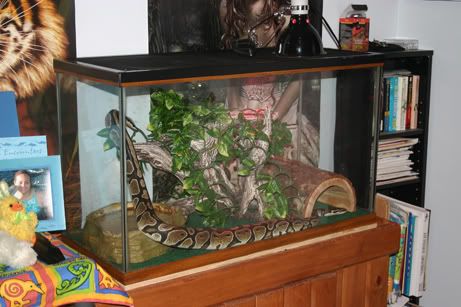There are so many and various places for Ball Python Habitats, Ball Python Habitat is also a home (our home), so you can breed them in your home. In a home you can make special place for Ball Python such as box place made from glass just aquarium and in the place you can add or give something that Ball Python like or exactly they want to live there naturally, this case you have to add the leaves around some special places for Ball Python for it to sleep and resting.
The ball python is often a nocturnal animal. In daytime, the ball python can usually be within dark areas like underground holes and burrows. It will eventually rarely live in outdoors, preferring to rest within tight quarters. The ball python will estivate during summertime by staying inactive underground.
Ball Python Habitat

drsfostersmith.com

For all fascinated by the thought of buying a snake as a pet, the ball python or Python Regius is a good choice! Renowned for their docile and endearing attributes, ball pythons aren't just small bigger (as compared with other pythons!) as well as simple to deal with, but they're also non-poisonous. These pythons manage to get their name using their company habit of curling in to a ball, with the head from the center, when they're nervous or scared. At birth, these pythons are about 14-18 inches long and become adults to about 3-5 feet in total. Their black, brown and tan spots help that you easily identify these pythons within their natural settings. Let's find out more on ball python habitat.




Ball pythons do shed their skin. Based on their growth, a ball python may shed 2-3 times annually. A ball python will usually begin spending added time in water just days before shedding. After about 5 days of swimming then sunbathing, the ball python decide to shed. It will eventually spend hours rubbing against a rock or tree to loosen its skin before sliding completely out.
Ball Python's Natural Habitat
A native to West Africa, these pythons today are only living on two continents worldwide: Africa and North America. Every year, numerous ball pythons were imported into America, thereby increasing their numbers for the American continent. These are comfortable living on trees as well as on the causes of the savannas and grasslands of Africa. Into their natural habitat, these snakes experience high levels of humidity, and also dry and wet seasons. The acres of grasslands form perfect habitats to the snakes. Moreover, the mice and rodents found there form lovely meals for ball pythons. Being nocturnal animals, ball pythons are mostly found sleeping in burrows and holes during the day.
In these pictures above we can see the sample and some ways or tips to breed Ball Python snake or use them as our pet. so just take it easy.